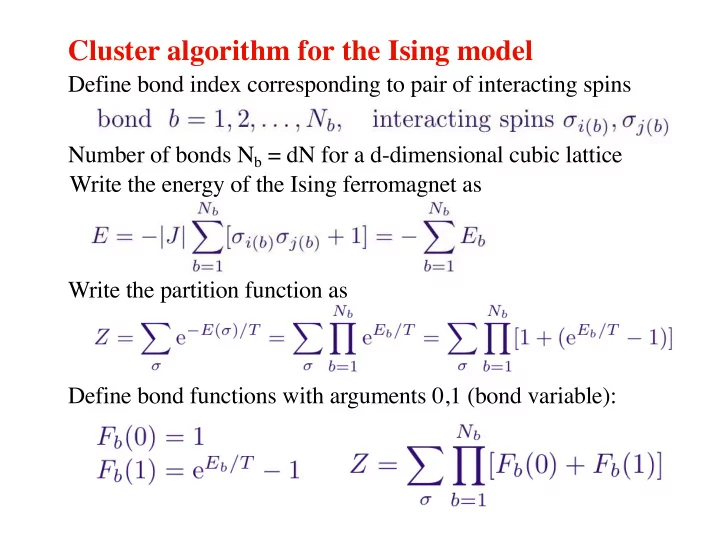

Cluster algorithm for the Ising model Define bond index corresponding to pair of interacting spins Number of bonds N b = dN for a d-dimensional cubic lattice Write the energy of the Ising ferromagnet as Write the partition function as Define bond functions with arguments 0,1 (bond variable):
Introduce bond variables Partition function can be written as sum over spins and bonds The functions F b depend on the spins: allowed only between parallel spins Probabilities: For everything else fixed, probability for a given b If parallel spins on bond b, probabilities for the bond variable If anti-parallel spins on bond b
For a fixed bond configuration, spins forming clusters (spins connected by “ filled ” bonds) can be flipped and then give a configuration (term) with the same weight in Z (F b =1 for all bonds between clusters, F b unchanged inside cluster). (unchanged after flip) Spins not connected to any filled bonds are single-spin clusters Swendsen-Wang algorithm • Start from spin configuration • Generate bond configuration • Identify clusters of spins connected by bonds • Flip each cluster with probability 1/2 • Generate new bonds with the current spins, etc
Integrated autocorrelation times - z=0 for Swendsen-Wang in two dimensions? - log-divergence of autocorrelation time? - More likely z ~ 0.3 (hard to distinguish L z and log if z small)
Cluster finding/flipping Clusters can be constructed and flipped in the same process Ø Decide whether or not to flip (50% probability) before starting Store array with flags for spins visited • Start with spin that has not been visited; seed of cluster • Add connected (by filled bonds) neighbors to cluster • Examine the non-visited neighbors of the new spins added • Add connected neighbors to cluster • Until no more spins in the cluster with non-visited neighbors Use stack to store spins with neighbors to be examined
Programming the Swendsen-Wang algorithm To construct clusters, we need arrays containing • Neighbors of given site s: neighbor(i,s) • Two spins connected by given bond b: bondspin(i,b ) • Bonds connected to given spin s: spinbond(i,s) Labeling of spins and bonds; example in 2D
Storing spin and bond variables in one-dimensional vectors spin(0:n-1), bond(0:d*n-1) Construction of lattice arrays in 2D subroutine lattice subroutine lattice do s0=0,n-1 neighbor(1,s0)=s1 x0=mod(s0,lx) neighbor(2,s0)=s2 y0=s0/lx neighbor(3,s0)=s3 x1=mod(x0+1,lx) neighbor(4,s0)=s4 x2=mod(x0-1+lx,lx) bondspin(1,2*s0)=s0 y1=mod(y0+1,ly) bondspin(2,2*s0)=s1 y2=mod(y0-1+ly,ly) bondspin(1,2*s0+1)=s0 s1=x1+y0*lx bondspin(2,2*s0+1)=s2 s2=x0+y1*lx spinbond(1,s0)=2*s0 s3=x2+y0*lx spinbond(2,s0)=2*s0+1 s4=x0+y2*lx spinbond(3,s1)=2*s0 spinbond(4,s2)=2*s0+1 end do
Main program bprob=1.d0-exp(-2.d0/temp) do i=1,steps/4 call castbonds call flipclusters enddo do j=1,bins call resetbindata do i=1,steps call castbonds call flipclusters call measure enddo call writebindata(n,steps) enddo
Generating bond configuration subroutine castbonds subroutine castbonds do b=0,2*n-1 if (spin(bondspin(1,b))==spin(bondspin(2,b))) then if (ran()<=bprob) then bond(b)=.true. else bond(b)=.false. endif else bond(b)=.false. endif enddo
Construct/flip clusters notvisited(s) = .true. for spins not yet visited notvisited(s) = .false. for spin that have been visited subroutine flipclusters subroutine flipclusters notvisited(:)=.true. cseed=0 1 if (ran()<0.5d0) then flipclus=.true. else flipclus=.false. endif notvisited(cseed)=.false. if (flipclus) spin(cseed)=-spin(cseed) nstack=1 stack(1)=cseed ......
do if (nstack==0) exit s0=stack(nstack) nstack=nstack-1 do i=1,nbors s1=neighbor(i,s0) if (bond(spinbond(i,s0)).and.notvisited(s1)) then notvisited(s1)=.false. if (flipclus) spin(s1)=-spin(s1) nstack=nstack+1 stack(nstack)=s1 endif enddo enddo do i=cseed+1,n-1 ! find starting spin if (notvisited(i)) then ! for the next cluster cseed=i goto 1 endif enddo
Recommend
More recommend